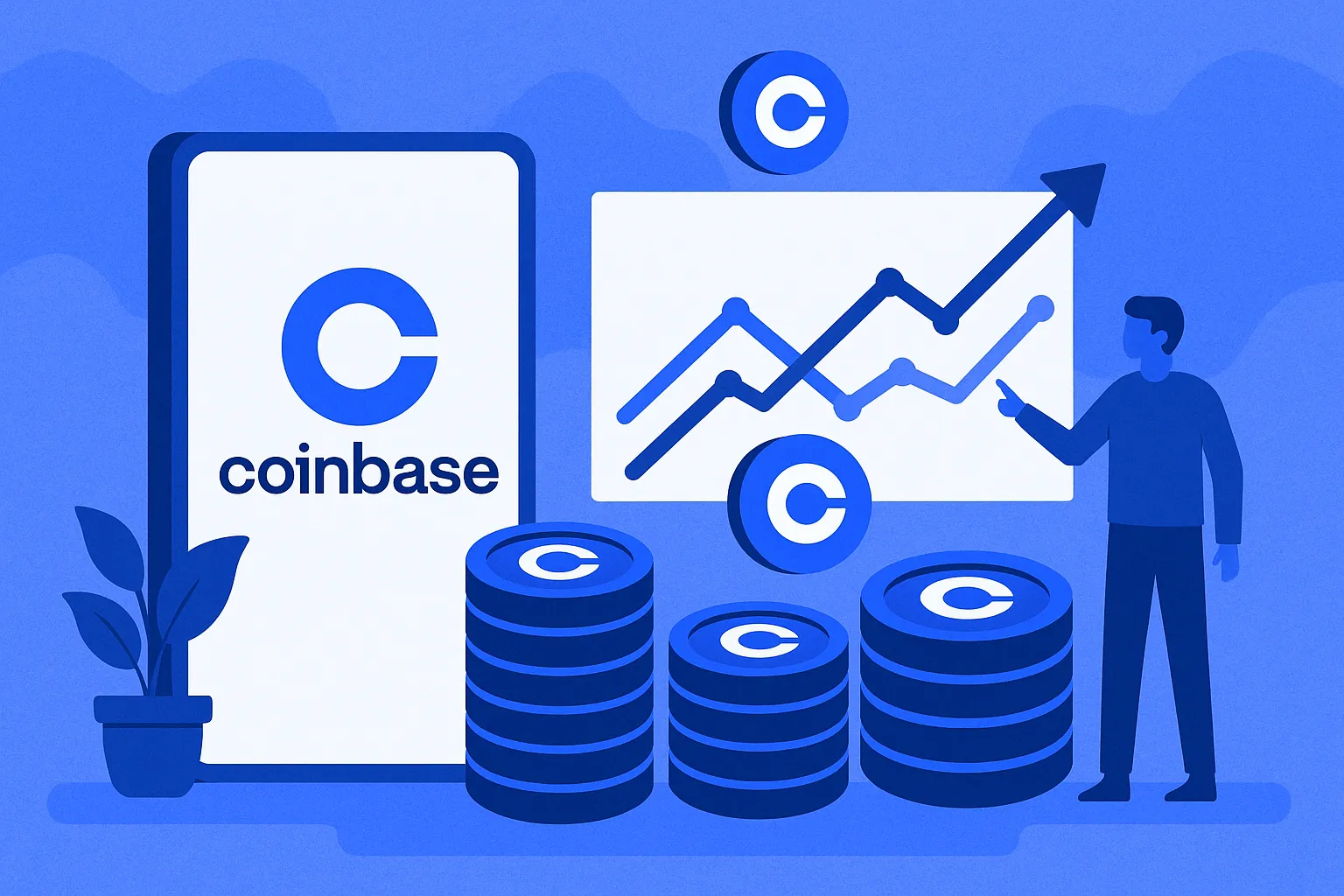Coinbase has become one of the most trusted names in the cryptocurrency world. Launched in 2012, it offers a simple platform for buying, selling, and managing digital assets. From individual traders to institutional investors, millions rely on to access the crypto economy securely.
Its business model is worth studying because it combines multiple revenue streams—from trading fees to subscription services—while maintaining regulatory compliance and scaling globally. If you’re a founder planning to build a crypto exchange app, understanding how operates will help you design a sustainable and profitable platform
What is Coinbase & How It Works
Coinbase is a cryptocurrency exchange and wallet platform that makes it easy for anyone to access digital currencies like Bitcoin, Ethereum, and thousands of other tokens.
The Problem It Solves:
Before Coinbase, buying crypto was complicated, often requiring technical knowledge, direct blockchain interactions, or unregulated peer-to-peer trades. Coinbase simplified this with a user-friendly interface and regulatory compliance, bringing crypto investing to the mainstream.
Who Uses It:
- Retail investors who want to buy, sell, or hold crypto
- Traders seeking advanced tools for real-time market execution
- Businesses accepting crypto payments
- Institutions managing large-scale digital asset portfolios
How its work Coinbase Operates:
- Account Creation: Users sign up, verify identity (KYC), and link payment methods.
- Trading: Customers can instantly buy/sell crypto with fiat currencies or trade pairs.
- Storage: Assets are held in secure hot wallets (for liquidity) and cold storage (for safety).
- Payments: Merchants can accept crypto through Commerce.
- Institutional Services: Custody solutions and trading APIs serve enterprise clients.
- Subscription Products: Premium offerings like Coinbase One give users extra benefits for a monthly fee.
By combining trading, storage, and payment infrastructure, Coinbase has built a powerful ecosystem that monetizes every stage of the crypto user journey.
Read More : What is Coinbase App and How Does It Work?
Target Audience
Coinbase serves a diverse range of customer segments, each with unique needs and behaviors. Here’s a closer look at who uses the platform:
- Retail Investors:
Everyday individuals buying small to moderate amounts of crypto for investment or curiosity. These users value simplicity, security, and the ability to cash out easily. - Active Traders:
More experienced traders who need advanced charting tools, API access, and lower fees for high-volume trading. - Institutions:
Hedge funds, family offices, and corporations managing large crypto portfolios, using for custody, compliance, and liquidity. - Businesses and Merchants:
Companies accepting crypto payments via Commerce and integrating digital assets into their workflows. - Developers and Builders:
Teams creating crypto apps and services who leverage APIs for price data, payments, and trading capabilities.
This wide target audience is a big reason why business model is so robust—it captures value from beginners to professionals.
Features that Support the Business Model
Coinbase’s success is driven by a set of core features that generate revenue and deepen user engagement. If you’re planning to build your own crypto exchange, these are the pillars to consider:
- Instant Buy & Sell:
Users can purchase crypto instantly with credit cards, debit cards, or bank transfers. This convenience drives transaction fees—Coinbase’s largest revenue source. - Secure Wallets:
offers custodial wallets where users store their assets. The ease of use and insurance coverage builds trust and keeps funds on the platform. - Advanced Trading Platform (Coinbase Pro):
Active traders get access to detailed charts, order books, and lower fees, attracting high-volume transactions and boosting liquidity. - Recurring Buys:
Customers can set up automatic purchases (e.g., weekly Bitcoin buys), ensuring steady fee income and higher retention. - Staking & Yield:
Coinbase lets users stake assets like Ethereum and earn rewards, taking a commission on staking payouts. - Subscription Plans (Coinbase One):
For a monthly fee, subscribers enjoy zero trading fees, dedicated support, and insurance benefits—an important diversification beyond transaction revenue. - Merchant Services:
Coinbase Commerce enables businesses to accept crypto payments, expanding the user base and transaction volume.
These features work together to create a flywheel: more users lead to more liquidity, more liquidity attracts institutions, and recurring services stabilize revenue.
Read More : Best Coinbase Clone Scripts in 2025: Features & Pricing Compared
Revenue Streams of Coinbase
Coinbase doesn’t rely on just one income source. Instead, it has built a diversified revenue model that balances trading fees with subscription income and institutional services.
Below is a table summarizing the main revenue streams:
| Revenue Stream | How It Works |
| Trading Fees | Percentage fees on each buy/sell transaction. This is the largest revenue driver. |
| Spread | Coinbase charges a spread between buy and sell prices, effectively earning on price differences. |
| Subscription Fees | Monthly plans with zero trading fees and premium support. |
| Staking Commissions | A cut of staking rewards earned by users who lock up tokens through the platform. |
| Custody Services | Fees for secure institutional-grade storage of crypto assets. |
| Commerce Transaction Fees | Charges applied to merchants accepting payments via Commerce. |
| Interest Income | Earnings from holding customer fiat balances and lending crypto to institutions. |
Quick Explanations:
- Trading Fees:
Retail traders pay higher percentages, while Pro traders pay tiered rates based on volume. - Spread:
The difference between the buy and sell price can range from 0.5–2%, depending on volatility. - Subscriptions:
Predictable monthly income that reduces reliance on trading activity alone. - Staking:
Coinbase facilitates staking and keeps a share of the yield, often 25–35%. - Custody & Institutional:
High-value clients pay for secure storage, compliance, and dedicated account management.
This blend of transaction-driven and recurring revenue makes Coinbase more resilient to crypto market swings.
Read more : Revenue Model of Coinbase: How the Crypto Giant Monetizes Trust and Transactions
Cost Structure
Running a platform like Coinbase requires significant investment in technology, compliance, and customer support. If you’re considering building a crypto exchange, these are the key cost categories you’ll need to plan for:
- Technology & Infrastructure:
- Cloud hosting and data storage for wallet services and trading platforms
- Security infrastructure to protect user funds (cold storage, encryption, threat monitoring)
- Engineering and product development teams
- Cloud hosting and data storage for wallet services and trading platforms
- Regulatory Compliance:
- Licensing costs across multiple jurisdictions
- Know Your Customer (KYC) and Anti-Money Laundering (AML) verification processes
- Legal teams and regulatory reporting
- Licensing costs across multiple jurisdictions
- Customer Support & Operations:
- 24/7 helpdesk and account recovery
- Fraud prevention and dispute resolution
- 24/7 helpdesk and account recovery
- Marketing & User Acquisition:
- Performance marketing, partnerships, and referral programs
- Educational content and brand campaigns
- Performance marketing, partnerships, and referral programs
- Insurance & Safeguards:
- Insurance premiums to protect against breaches and theft
- Reserve funds for operational contingencies
- Insurance premiums to protect against breaches and theft
- General & Administrative:
- Office operations, HR, and management overhead
- Office operations, HR, and management overhead
These costs scale with user growth and transaction volume, so strong monetization is essential to maintain healthy margins.
2025–2026 Innovations or Updates
Coinbase has continued to evolve rapidly, introducing new products and adapting to shifting market conditions. Here are some of the most notable developments in 2025–2026:
- Enhanced Subscription Offerings:
Coinbase expanded its One subscription with additional perks such as priority phone support, higher staking rewards, and early access to new tokens. This helps drive predictable monthly revenue. - Global Expansion:
The platform accelerated entry into Latin America, Southeast Asia, and Africa, acquiring licenses and building local fiat on-ramps. This global focus supports user growth beyond saturated U.S. and European markets. - Institutional Upgrades:
New custody solutions and deeper liquidity pools were rolled out to attract large funds and corporates, reinforcing leadership in the institutional crypto segment. - Improved Staking Experience:
Coinbase streamlined staking interfaces and introduced educational content to boost adoption among retail users. This led to higher staking volumes and increased staking commissions. - NFT Marketplace Integration:
Coinbase integrated NFT support more tightly into the main app, offering users the ability to trade digital collectibles alongside traditional crypto assets. - Regulatory Alignment:
Additional compliance tooling was implemented to meet evolving regulatory frameworks, such as MiCA in Europe and enhanced KYC requirements in the U.S.
These innovations show how continually adapts its business model to diversify revenue and reduce dependence on trading fees alone.
Takeaways for Startup Founders
If you’re thinking about building a crypto exchange app inspired by Coinbase, here are some key lessons and recommendations to keep in mind:
- Diversify Revenue Early:
Relying only on trading fees makes your business vulnerable to market cycles. Consider adding staking, subscriptions, and custody services to stabilize income. - Prioritize Trust and Security:
Coinbase’s growth was built on user confidence. Investing in robust security, insurance coverage, and clear compliance processes is essential to attract and retain customers. - Segment Your Audience:
Serving both casual investors and institutional clients requires tailored experiences—different fee structures, support levels, and tools. Plan your user flows and pricing accordingly. - Simplify User Experience:
Even advanced traders appreciate intuitive interfaces. Coinbase made crypto accessible by reducing complexity—something every successful fintech app gets right. - Invest in Education:
Many users are still new to crypto. Providing guides, tutorials, and transparent fee explanations increases engagement and reduces churn.
If you want to launch your own crypto trading platform, Miracuves can help you get there faster. We specialize in building ready-made like apps, complete with secure wallets, trading engines, and staking modules.
Read more : Revenue Model of Coinbase: How the Crypto Giant Monetizes Trust and Transactions
Conclusion :
Coinbase has proven that a crypto exchange can be both profitable and trusted by millions. Its business model blends transaction fees, subscriptions, staking rewards, and institutional services to create a resilient revenue engine.
If you’re a founder inspired to build your own crypto trading platform, the time is right. The market is expanding globally, and users expect secure, user-friendly experiences.
Contact with Miracuves launch your Coinbase-inspired app faster and more cost-effectively. We offer robust, customizable solutions that cover everything from trading infrastructure to compliance features—so you can focus on growing your brand.
Get started with your crypto exchange project today.
FAQs :
1. How does Coinbase make most of its money?
The largest portion of Coinbase’s revenue comes from transaction fees and spreads charged on each crypto trade. Retail users pay higher percentages, while professional traders on Pro enjoy lower, volume-based fees.
2. Is Coinbase profitable?
Coinbase has reported profitable quarters, especially during strong crypto bull markets when trading volumes surge. However, like many exchanges, its profitability fluctuates with market cycles.
3. What are Coinbase subscriptions?
Coinbase offers a subscription called One. For a monthly fee, users get benefits like zero trading fees, priority customer support, and enhanced insurance coverage.
4. What makes Coinbase different from other exchanges?
Coinbase stands out for its strong regulatory compliance, insurance protections, and simple user experience. These factors have helped it build credibility with both retail investors and institutions.
5. Can I build an app like Coinbase?
Yes. With the right technology partner, you can create a secure, scalable crypto trading platform. Miracuves offers customizable solutions so you can launch faster and focus on acquiring users. Learn more here.
Related Articles :








